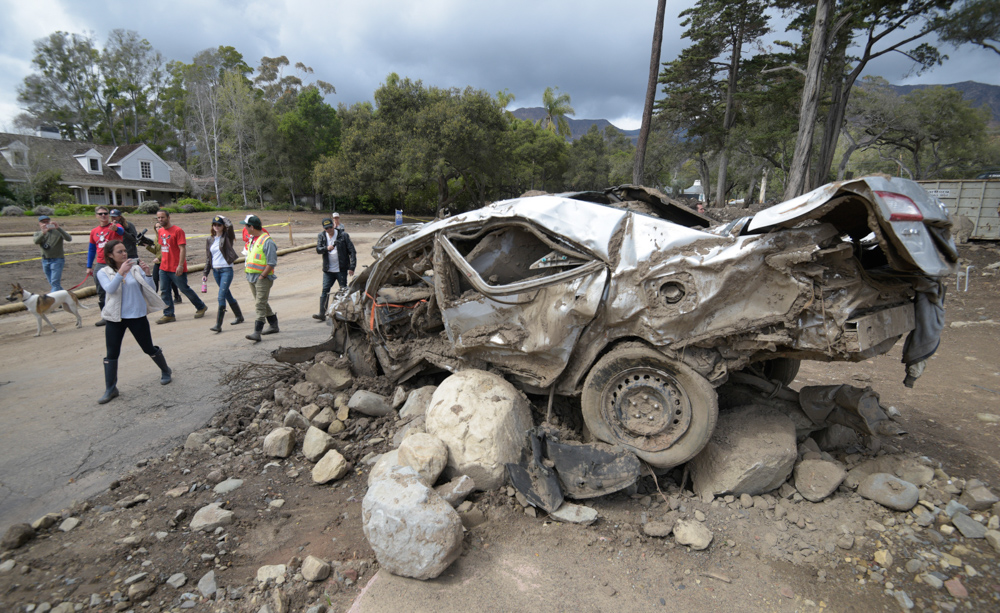Study: Debris Flow Warnings Were Confusing, Unconvincing
Victims' Families Furious at County Failures But Thwarted By Government Immunity

The final results of a study that measured the effectiveness of public warnings issued before the deadly 1/9 Debris Flow have confirmed what many in Montecito already knew — that the communications and evacuation notices they received from authorities were woefully inadequate in educating them to the extreme danger they faced. The study comprised a large community survey administered since May by the National Weather Service in partnership with the University of Alabama’s Center for Advanced Public Safety.
Researches received 404 responses from Montecito area residents ranging in age from teens to the retired. The vast majority — 90 percent — had registered with the County of Santa Barbara’s Aware & Prepare alert system prior to the debris flow. Fifty-three percent of respondents lived in what officials at the time defined as the “voluntary evacuation zone,” the area of Montecito south of Highway 192 where 19 of the disaster’s 23 victims were killed. Twenty-two percent lived in the mandatory evacuation area, and the remaining 25 percent said they were unsure in which zone they lived.
Respondents described being confused by the conflicting maps and written descriptions of the two evacuation areas provided by the County’s Office of Emergency Management (OEM), which differed from the regions along creek channels that officials also said were at risk. Residents said they were similarly confused by the term “debris flow,” the language used to describe the intensity of a storm that could trigger one, and the ambiguous cell phone alert they received in the midst of the chaos to “GO TO HIGH GROUND.” Eighty-three percent said they knew about the expected rainstorm; 62 percent had heard about the possibility of a debris flow.
The survey asked people who remained home despite the warnings why they chose not to evacuate. The most common response was evacuation fatigue brought on by the multiple prior evacuations ordered during the Thomas Fire; seventy-five percent said they left during the fire, while only 28 percent did before the debris flow. Those who lived through the big 1969 storm that caked Montecito in heavy mud were more likely to leave, the results showed. Sheriff Bill Brown has been criticized within his ranks for potentially contributing to the community fatigue by bucking the recommendations of incident commanders and waiting three days after the Thomas Fire danger had subsided to repopulate Montecito.
The next most common answer given for not evacuating was the false sense of security offered by the OEM’s description of the voluntary evacuation zone, which told residents to “stay alert to changing conditions and be prepared to leave immediately.” Many said they packed their cars and watched the weather only to have earth and rock crash through their homes with little to no warning. Authorities also never informed residents that they shouldn’t rely on rainfall intensity over their homes to gauge the ferocity of the storm in the mountains, where debris flows originate. Brown was rebuked by surviving family members shortly after the disaster when he said victims had “misinterpreted” their level of safety.
County and National Weather Service officials say they are using the results of the study and another conducted by Santa Barbara’s public-safety agencies to refine their messaging and better prepare the public for the next incident. Major changes have already been made to the way OEM describes and notices evacuations, including its new Ready, Set, Go initiative, which provides a timeline of how and when alerts are broadcast. The county also recently completed an After-Action Report that identifies lessons learned and areas for improvement.
In the year since the disaster, family and friends of the 23 victims have quietly seethed over the communication failures outlined in the survey. They’ve also pointedly questioned why local authorities drew an east-west evacuation boundary along Highway 192 when they were told by state scientists that the predicted debris flow would very likely travel along the north-south gulleys of creeks and might flow well below the 192.
Outrage over these issues has been channeled into multiple wrongful-death lawsuits, not against Santa Barbara County, but against Southern California Edison, whose electrical equipment is alleged to have triggered the Thomas Fire that set the stage for the debris flow. The prevailing legal wisdom among attorneys representing the Montecito families, who spoke only on background due to the pending litigation, is that the county, while potentially liable, is so well-shielded from civil actions by government immunity laws that succeeding in a lawsuit against it would be nearly impossible. Public utilities do not enjoy the same protections.
The multiple wrongful-death cases have been consolidated into a single, massive class-action complaint against Edison that includes claims by Ventura homeowners, insurance companies, and hundreds of other plaintiffs impacted by the Thomas Fire. The case is in its early stages, and no future hearing dates have been set.



